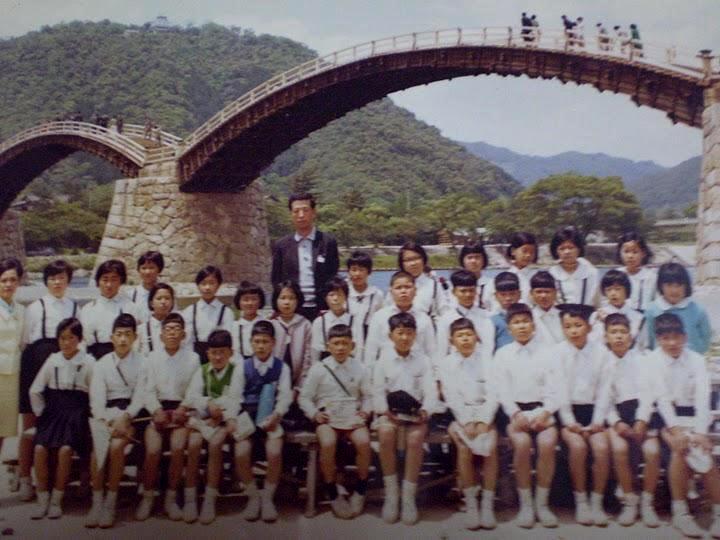
Japanese School Chronology: The 1970s

Figure 1.--Here we see an unidentified Japanese primary school class on a field trip, we thank to a park in 1970. Perhaps a reader will recognize the park. The boys ear white shorts and navy blue shorts. The girls wear white blouses, some with large Peter Pan collars, and suspender skirts. They all wear white socks and sneakers. The children are 6th graders, meaning age 11-12 years of age. This is probably their primary school graduation trip.
|
|
The basic differences between primary and secondary schools continued in the 1970s. More Japanese primary schools adopted basic uniforms in the 1970s. It is difficult to determine the relative prevalence of uniform and non-uniform schools. We believe about one-third of Japanese schools decided to adopt uniforms. Most schools did not. But quite a number did. We are not sure if there were any demographic or social class factors at play here. We think the uniforms were less common in the rural and small town schools, but can not yet definitively make that statement. As far as weknow it was entirely up to each school to decide on their own. And they were also free to determoine the style of the uniform for their school. At the primary level the cadet uniforms become relatively incommon, although a few schools adopted them. With the new uniform, both boys and girls wore them. More common was a basic white shirt for the boys and blouse for the girls. The girls often had blouses with Peter Pan collars. The other basic part of the uniform was navy blue pants for the boys and suspender skirts for the boys. Suspender shorts for the boys were much less common. We do not notice other shades of blue being used, although there was more variability at the pre-prep level. As far as we can tell, the boys' uniform was always short pants. The standard was naby blue shorts and skirts, but we also see grey and other colors as well as in a few instances a plaid pattern. Navy blue was by far the most common. Some schools also had blazers done in an Eton style without lapels. A few schools adopted sailor-style uniforms for the girls. The uniform was usually worn with white socks, both ankle socks and knee socks. The socks were usually, but not always white. Younger children might wear tights. White sneakers were very common. The schools were often not as strict with the hosiery and shoes as wih other prts opf the uniform. Most schools had caps or hats, in a few cases matching the blazer and shorts/skirts. This basic uniform was commonly worn throughout the 1970s. Some children at the non-uniform schools, might wear some of the uniform items. There were no changes at the secondary schools. Most continued to require the Prussian cadet uniformsd for the boys and sailor outfits for the girls.
HBC-SU

Related Chronolgy Pages in the Boys' Historical Web Site
[20th century]
[The 1900s]
[The 1910s]
[The 1920s]
[The 1930s]
[The 1940s]
[The 1950s]
Navigate the Boys' Historical Clothing School Uniform Pages
[Return to the Post-war 20th century Japanese school decade trends page]
[Return to the Main Japanese School Uniform Chronology Page]
[Australia]
[England]
[France]
[Germany]
[Ireland]
[Italy]
[Japan]
[New Zealand]
[Scotland]
[United States]
Related Style Pages in the Boys' Historical Web Site
[Long pants suits]
[Short pants suits]
[Socks]
[Eton suits]
[Jacket and trousers]
[Blazer]
[School sandals]
Navigate the Boys' Historical Clothing Web Page
[Return to Main school uniform page]
[Introduction]
[Activities]
[Biographies]
[Chronology]
[Cloth and textiles]
[Clothing styles]
[Countries]
[Topics]
[Bibliographies]
[Contributions]
[FAQs]
[Glossaries]
[Images]
[Links]
[Registration]
[Tools]
[Boys' Clothing Home]
Created: 11:30 PM 9/5/2011
Last updated: 11:30 PM 9/5/2011




